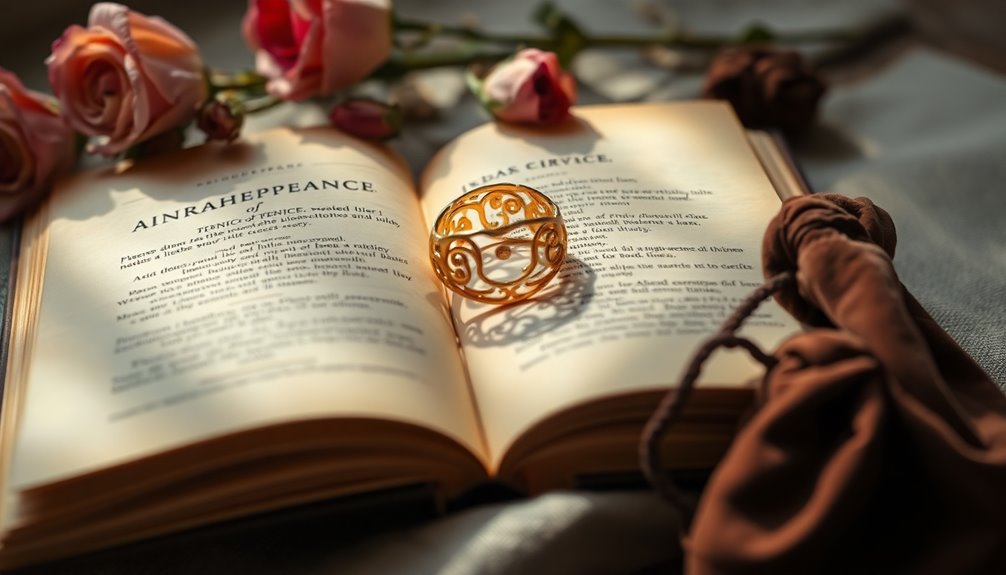Symbolism helps create a theme by revealing deeper meanings in a story that you might not notice at first. When you see objects or actions acting as symbols, they connect to big ideas, like hope or freedom. For instance, a broken chain might symbolize breaking free from oppression. These symbols make you feel strong emotions and create a bond with the characters. They also help you understand the central message of the story, guiding you on an exciting journey. Just think about how these connections transform your understanding, and you'll uncover even more fascinating insights ahead!
Key Takeaways
- Symbolism conveys abstract ideas, allowing themes to emerge through tangible representations within the narrative.
- Recurring symbols reinforce and highlight key themes, creating a cohesive narrative experience.
- Symbols reflect character development, illustrating their journeys and contributing to thematic depth.
- Cultural contexts enrich understanding of symbols, enhancing thematic exploration across diverse perspectives.
- Emotional resonance of symbols deepens reader connections, making themes more impactful and relatable.
Understanding Symbolism in Literature

Symbolism in literature serves as a powerful tool that deepens the reader's experience. It's like finding hidden treasures in a story! When you look closely, you can see how objects, characters, or actions carry deeper meanings that enrich the narrative.
For instance, in "The Great Gatsby," that green light isn't just a light; it symbolizes Gatsby's dreams and the elusive American Dream itself.
Characters can symbolize broader ideas, too. Take the mockingbird in "To Kill a Mockingbird," which represents innocence and helps reinforce the theme of moral nature in humanity. This makes you reflect on what's right and wrong.
Even actions can symbolize important events. In "Animal Farm," the rebellion represents the Russian Revolution, adding layers to the theme of power and corruption.
The Role of Theme in Storytelling

Every great story has a backbone that supports its structure and guides its direction—this is where theme comes into play. The theme is the central message or insight that the author wants to share with you. It shapes character development, influencing their choices and actions.
As you read, you'll notice how characters grow and change based on the themes at play. Thematic exploration allows you to dive deeper into universal ideas, sparking your thoughts about life and society. You'll find that effective themes often emerge through the characters' journeys and the symbolism woven throughout the story.
These symbols help to enhance the overall message, making it richer and more engaging. Authors love to present themes subtly, rather than shouting them out loud. This approach creates a magical experience, letting you draw personal connections and interpretations.
You might find yourself pondering the lessons hidden within the story long after you've finished reading. So, as you explore the world of literature, remember that theme isn't just a part of the story—it's the heart of storytelling that connects everything together!
How to Identify Symbolism

When diving into a story, you'll want to keep an eye out for elements that pop up repeatedly, as these often point to important symbols. To identify the theme, look for items, colors, or actions that keep showing up. These symbols can help you understand the main idea of the story. Remember, symbolism is one way to connect deeper meanings to the plot!
Next, consider the context in which a symbol appears. Its meaning can change based on what's happening or how characters interact. This adds emotional impact, making the story more relatable and powerful for you as a reader.
Also, think about how symbols affect the characters themselves. Their personal journeys can reveal much about character development and help you see the themes more clearly.
Lastly, reflect on cultural significance. Some symbols have meanings that everyone understands, which can enrich your understanding of the story.
Connecting Symbols to Themes

Recognizing symbols in a story opens up a pathway to understanding deeper themes. When you connect symbols to themes, you uncover the heart of the narrative and feel its emotional connections.
Symbols serve as tangible representations of abstract ideas, helping you grasp the theme of a story more clearly. Here's how symbols and themes work together:
- Universal Symbols: These evoke shared cultural meanings, like using light to represent knowledge.
- Personal Symbols: These reflect a character's individual struggles, deepening your connection to their journey.
- Recurring Motifs: When symbols repeat throughout a story, they emphasize central themes, guiding your interpretation.
- Emotional Connections: Symbols can tug at your heartstrings, making the themes resonate on a personal level.
- Layers of Meaning: The strategic use of symbols enriches the theme and invites you to explore nuanced interpretations.
Analyzing Examples of Symbolism

Let's explore some fascinating symbols in literature! Each symbol, like the green light in "The Great Gatsby" or the mockingbird in "To Kill a Mockingbird," carries deep meaning and can stir strong feelings in us.
Key Symbols in Literature
Numerous key symbols in literature provide powerful insights into abstract themes, making complex ideas more accessible to readers. Symbols act as bridges, connecting tangible items to deeper meanings.
Here are some examples that highlight this connection:
- The green light in "The Great Gatsby": Represents Gatsby's dreams and the elusive American Dream.
- The mockingjay in "The Hunger Games": A symbol of rebellion, showcasing the fight against oppression.
- The mockingbird in "To Kill a Mockingbird": Represents innocence, tying into themes of moral growth and social injustice.
- The whale in "Moby Dick": Serves as a representation of life's unknowable nature, illustrating obsession and the struggle against fate.
- The conch shell in "Lord of the Flies": Symbolizes order and civilization, emphasizing the theme of societal breakdown.
Each of these symbols enriches its story, making themes easier to understand and relate to.
They invite you to explore emotions and ideas that might be tough to grasp otherwise. By recognizing these symbols, you can reveal deeper meanings in literature, enhancing your reading experience and emotional connection to the story.
Symbolism's Emotional Impact
Symbols in literature pack an emotional punch, transforming abstract themes into relatable experiences. When you immerse yourself in a story, you'll notice how symbolism enriches the narrative. It allows you to connect deeply with the characters and their journeys. Here's a look at some powerful examples:
| Symbol | Emotional Impact |
|---|---|
| Green Light (The Great Gatsby) | Evokes aspiration and disillusionment, highlighting the corruption of the American Dream. |
| Thistle (Braveheart) | Represents love and sacrifice, linking to a character's past and enhancing emotional depth. |
| Mockingjay (The Hunger Games) | Serves as a symbol of rebellion and resilience, creating a strong connection with the audience. |
| Light (Universal Symbol) | Represents knowledge, evoking shared feelings across cultures and making themes accessible. |
| Rose (Various Narratives) | Symbolizes love and beauty, enhancing emotional tones and connections within stories. |
These symbols and motifs breathe life into themes, letting you feel what the characters feel. They create a bond between you and the story, making every moment more impactful. Additionally, the exploration of positive thinking reveals how literature can inspire personal transformation and resilience in readers. The emotional well-being fostered through these connections can lead to a deeper appreciation of life and its complexities. Furthermore, the use of symbolism often aligns with vibrational energy in the narrative, inviting readers to resonate with the underlying themes on a deeper level. This emotional resonance can be further understood through the concept of continuous learning, which encourages personal growth as readers reflect on the experiences presented in the narrative.
Cultural Contexts of Symbols
The cultural context of symbols enriches your understanding of their meanings in literature. When you explore different symbols, you uncover layers that make stories even more exciting!
These symbols often carry cultural significance, helping to create a thematic message that resonates with readers. Here are some examples:
- The color red can mean love in one culture and danger in another.
- The lotus flower represents purity and spiritual awakening in Eastern traditions.
- Chains symbolize oppression in Western literature, linking to freedom and rebellion.
- In Native American cultures, the eagle stands for strength and freedom, highlighting themes of survival.
- The olive branch is a universal symbol of peace, seen across various societies.
The Interplay Between Symbolism and Theme

Let's explore how symbolism and theme work together to create a richer story!
When you see symbols in a tale, they often show deeper feelings and ideas, helping you connect with the characters and their journeys.
This exciting interplay makes the story more meaningful, as each symbol adds layers of emotion and thought that can surprise and inspire you!
Symbolism Enhances Thematic Depth
Enhancing thematic depth through symbolism allows readers to connect with complex ideas on a more profound level. When you notice how symbols weave into a story, it becomes easier to understand the thematic statement.
Here's how symbolism adds richness to a narrative:
- Tangible Representations: Symbols turn abstract themes into something you can visualize.
- Character Development: As characters grow, the symbols around them can change, showing their journey.
- Recurring Symbols: These motifs highlight important themes, making them memorable.
- Cultural Connections: Universal symbols tap into shared emotions, enhancing your understanding.
- Emotional Resonance: When you see how symbols relate to characters, you feel deeper connections and empathy.
Symbols Convey Emotional Resonance
Symbols often convey deep emotional resonance, allowing you to connect with themes on a personal level. When you read a story, symbols like a broken chain or a withering plant can spark feelings that make the theme come alive. These symbols help you understand the characters' journeys and struggles more deeply, as they often represent their internal battles.
Here's a table to show how symbols can enhance emotional connections:
| Symbol | Emotional Connection | Theme |
|---|---|---|
| Broken chain | Freedom and liberation | Breaking free from oppression |
| Withering plant | Declining hope | Despair and loss |
| A cherished object | Memory and grief | The impact of loss |
| Recurring symbol | Emotional rhythm | Consistency in struggle |
Frequently Asked Questions
How Do Symbols Help Develop Theme?
Symbols help develop themes by connecting big ideas to everyday experiences. When you see a symbol repeatedly, it reinforces the main message of the story.
For example, a broken clock might represent lost time. It makes you think! Personal symbols tied to characters' lives show how their journeys relate to larger themes.
Plus, universal symbols can spark feelings shared by many. This connection makes your reading more exciting and meaningful!
How Does Symbolism Help the Theme?
Imagine walking through a garden filled with colorful flowers, each representing a different idea.
That's how symbolism works in stories! It helps you understand themes by connecting complex ideas to simple symbols.
When you spot a recurring symbol, like a key opening a door, it reveals more about the story's message.
Symbols can make you feel emotions too, deepening your connection to the characters and their journeys, making reading a joyful adventure!
How Does Symbolism Help a Reader?
Symbolism helps you dive deeper into a story! When you spot a symbol, like a heart or a broken chain, it connects you to the emotions and ideas behind the words.
These symbols make the story feel real and relatable. They guide you to discover hidden meanings and themes.
As you notice symbols, you'll start to see how they enrich the narrative, making your reading experience more exciting and meaningful!
What Does Symbolism Help Create?
Symbolism helps create a vivid landscape in stories, painting deeper meanings with colorful strokes. When you see a red rose, you might think of love, right? That's how symbols work! They turn ordinary objects into powerful ideas, making the story come alive.
Conclusion
Ultimately, symbolism sprinkles stories with meaning, making themes shine brighter! By spotting symbols, you reveal deeper insights and discover delightful connections. Remember, every symbol tells a story, helping you explore the emotions and ideas behind the text. So, as you read, keep your eyes peeled for those special symbols. They'll lead you on a thrilling journey through the heart of the theme. Happy reading, and let your imagination soar!











